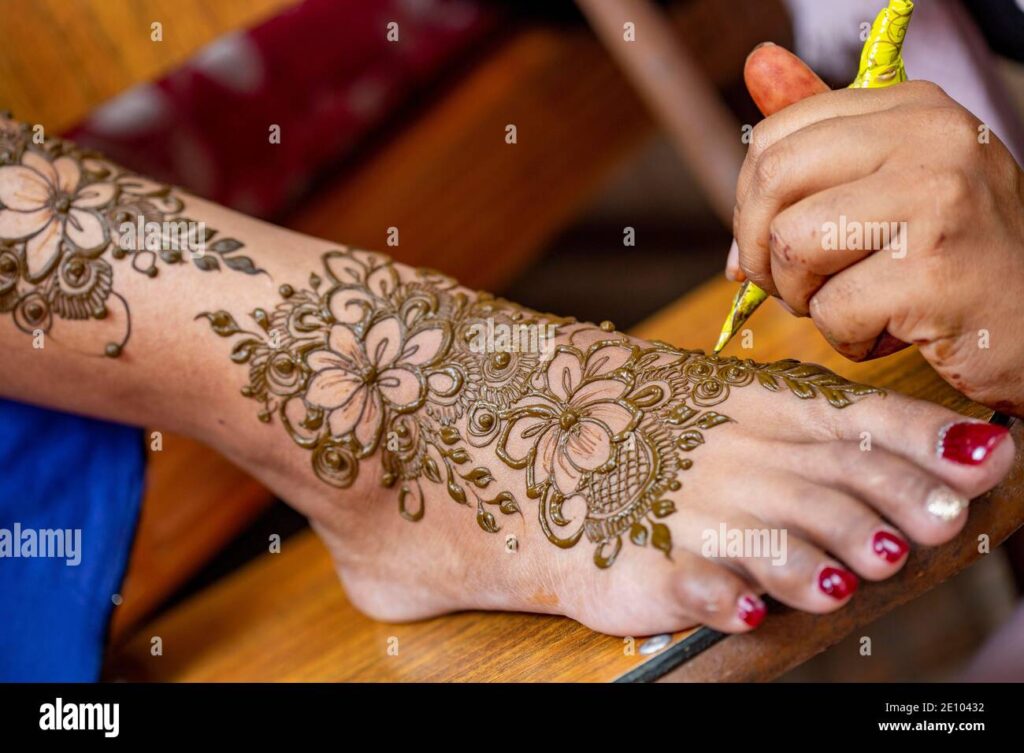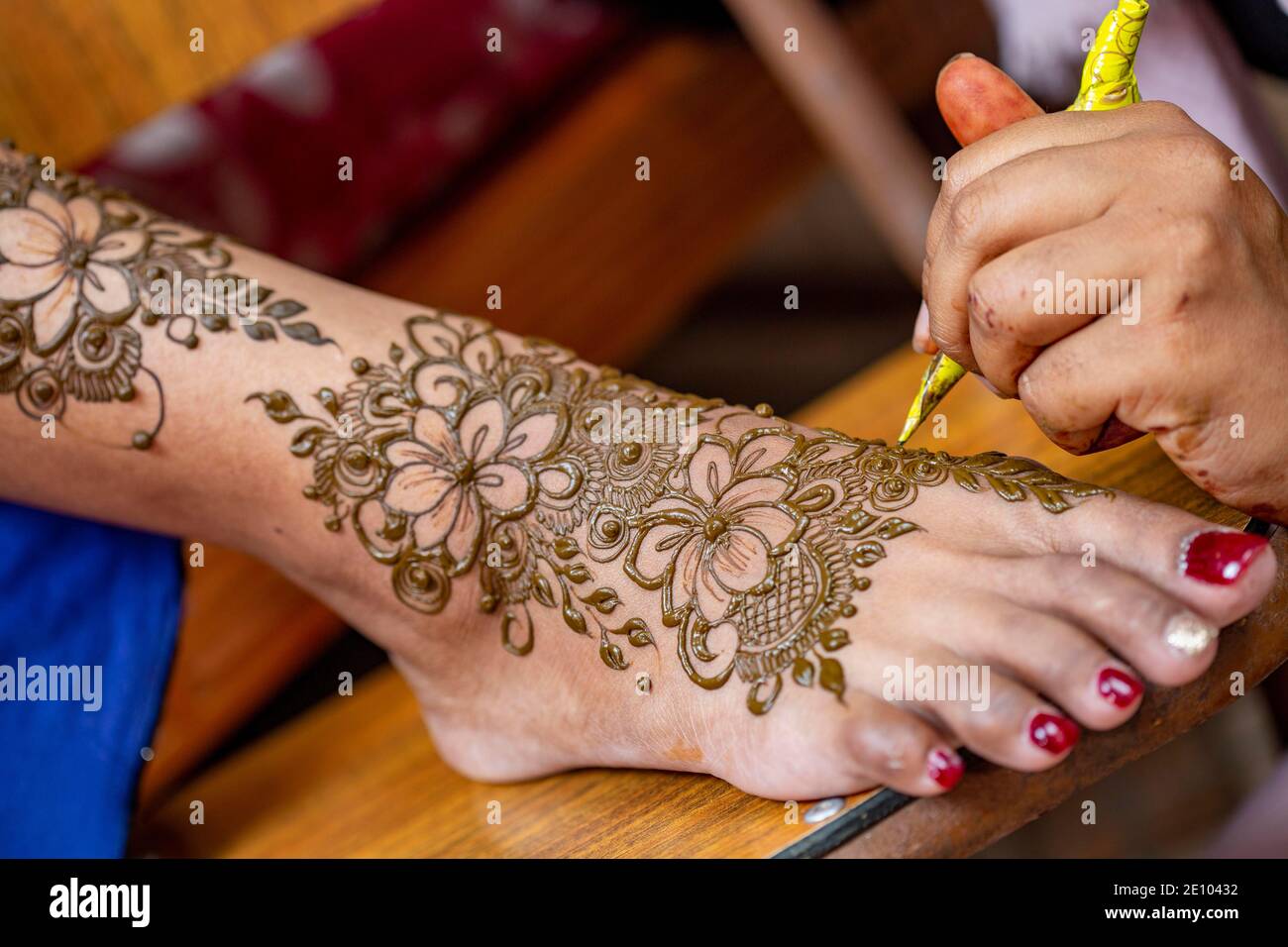
Intricate Inks: Exploring the Art and Allure of Foot Tattoo Henna
Foot tattoo henna offers a captivating blend of ancient tradition and modern self-expression. Unlike permanent tattoos, henna provides a temporary canvas for intricate designs, allowing individuals to adorn their feet with beautiful artwork without the lifelong commitment. This article delves into the history, application, cultural significance, and contemporary trends surrounding foot tattoo henna, providing a comprehensive understanding of this increasingly popular art form.
The History and Cultural Significance of Henna
Henna, derived from the Lawsonia inermis plant, has been used for centuries across various cultures, primarily in South Asia, the Middle East, and Africa. Its use dates back to ancient Egypt, where it was employed for cosmetic purposes, including dyeing hair and decorating the bodies of pharaohs. In many cultures, henna is deeply intertwined with celebratory occasions, particularly weddings. Bridal henna, often applied to the hands and feet, symbolizes good luck, joy, and prosperity for the couple. The intricate designs are believed to ward off evil spirits and bring blessings to the marriage. The rich history of henna underscores its cultural importance and spiritual significance, making it more than just a cosmetic adornment.
The Art of Henna Application on Feet
Applying foot tattoo henna is a meticulous process that requires skill and artistry. The henna paste, typically made from dried henna leaves, lemon juice, and essential oils, is applied to the skin using a cone or applicator. The design is carefully drawn, often incorporating intricate patterns, floral motifs, or geometric shapes. The paste is left on the skin for several hours, allowing the dye to penetrate and stain the skin. The longer the paste remains, the darker and more lasting the stain will be. Once the paste is removed, the initial stain is typically orange, gradually darkening to a rich reddish-brown over the next 24 to 48 hours. The beauty of foot tattoo henna lies not only in the design itself but also in the temporary nature of the art, offering a unique and evolving form of self-expression.
Benefits of Choosing Henna for Foot Tattoos
There are several compelling reasons why individuals opt for foot tattoo henna over permanent tattoos. The most significant advantage is its temporary nature. This allows for experimentation with different designs and styles without the commitment of a lifetime. Foot tattoo henna is also a pain-free alternative to traditional tattooing, as it involves no needles or skin penetration. This makes it an appealing option for those who are hesitant about the pain associated with permanent tattoos. Furthermore, henna is generally considered safe when applied by a skilled artist using natural henna paste. However, it’s crucial to avoid black henna, which contains chemical dyes that can cause severe skin reactions. [See also: Safe Henna Practices] The natural and temporary qualities of henna make it a popular choice for those seeking a beautiful and non-permanent form of body art.
Popular Foot Tattoo Henna Designs and Trends
The world of foot tattoo henna designs is vast and diverse, offering endless possibilities for creative expression. Floral patterns, geometric shapes, and traditional motifs are among the most popular choices. Mandala designs, with their intricate circular patterns, are particularly favored for their spiritual symbolism and aesthetic appeal. Tribal patterns, inspired by various cultures around the world, add a bold and exotic touch. Many individuals also opt for personalized designs that reflect their interests, beliefs, or personal stories. The current trends in foot tattoo henna include minimalist designs, incorporating delicate lines and subtle details. Another popular trend is the use of white henna, which creates a striking contrast against the skin, offering a modern and elegant look. Whether it’s a traditional design or a contemporary creation, foot tattoo henna allows for endless customization and self-expression.
Caring for Your Foot Tattoo Henna
Proper care is essential to ensure the longevity and vibrancy of your foot tattoo henna. After the paste is removed, avoid washing the area with soap and water for at least 12 hours. Applying a natural oil, such as coconut oil or olive oil, can help to moisturize the skin and enhance the stain. Avoid excessive exposure to water, as this can fade the design more quickly. Exfoliating the skin will also accelerate the fading process. With proper care, a foot tattoo henna can last for one to three weeks, depending on the individual’s skin type and lifestyle. Regular moisturizing and gentle care will help to preserve the beauty of your henna art.
Choosing a Reputable Henna Artist
Selecting a skilled and reputable henna artist is crucial to ensure a safe and satisfying experience. Look for an artist with extensive experience, a portfolio of their work, and positive reviews from previous clients. Inquire about the ingredients used in the henna paste to ensure that it is made with natural henna and free from harmful chemicals. Avoid artists who use black henna, as it can cause severe allergic reactions and permanent scarring. A reputable artist will prioritize your safety and provide guidance on aftercare to ensure the best possible results. Taking the time to research and choose a qualified artist will help you to enjoy a beautiful and worry-free foot tattoo henna experience. [See also: Finding a Qualified Henna Artist]
The Growing Popularity of Henna Foot Art
The rising popularity of foot tattoo henna reflects a growing interest in temporary body art and self-expression. Social media platforms have played a significant role in showcasing the beauty and versatility of henna designs, inspiring individuals to explore this ancient art form. Celebrities and influencers have also contributed to the trend, further popularizing foot tattoo henna among a wider audience. The temporary nature of henna allows for experimentation and creativity, making it an appealing option for those who want to express themselves without the commitment of a permanent tattoo. As the demand for temporary body art continues to grow, foot tattoo henna is poised to remain a popular and beloved form of self-expression.
Henna Foot Tattoos: A Fusion of Tradition and Modernity
Foot tattoo henna represents a beautiful fusion of tradition and modernity. It honors the rich cultural heritage of henna while embracing contemporary trends and styles. The intricate designs, the temporary nature of the art, and the pain-free application make it an appealing option for individuals of all ages and backgrounds. Whether it’s a traditional bridal design or a modern minimalist creation, foot tattoo henna offers a unique and personal form of self-expression. As the art of henna continues to evolve, it remains a timeless and cherished tradition that celebrates beauty, culture, and individuality. The versatility of foot tattoo henna allows for endless possibilities, ensuring its continued popularity for generations to come.
In conclusion, foot tattoo henna is more than just a temporary adornment; it’s a celebration of culture, artistry, and self-expression. From its ancient origins to its modern-day popularity, henna continues to captivate and inspire, offering a beautiful and meaningful way to adorn the body. The intricate designs, the temporary nature of the art, and the pain-free application make it an appealing option for those seeking a unique and personal form of body art. As the demand for temporary body art continues to grow, foot tattoo henna is poised to remain a beloved and cherished tradition.

